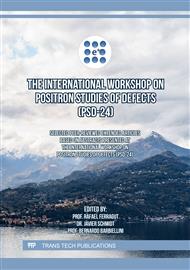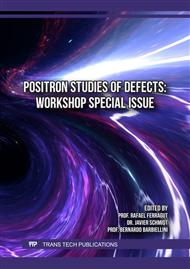[1]
S. Woltz, R. Hiergeist, P. Görnert, C. Rüssel, Magnetite nanoparticles prepared by the glass crystallization method and their physical properties, J. Magn. Magn. Mater. 298 (2006) 7-13.
DOI: 10.1016/j.jmmm.2005.02.067
Google Scholar
[2]
C. Worsch, P. Schaaf, R. Harizanova, C. Rüssel, Magnetisation effects of multicore magnetite nanoparticles crystallised from a silicate glass, J. Mater. Sci. 47 (2012) 5886-5890.
DOI: 10.1007/s10853-012-6490-3
Google Scholar
[3]
S. El Shabrawy, C. Bocker, M. Miglierini, P. Schaaf, D. Tzankov, M. Georgieva, R. Harizanova, C. Rüssel, Mössbauer study and magnetic properties of MgFe2O4 crystallized from the glass system B2O3/K2O/P2O5/MgO/Fe2O3, J. Magn. Magn. Mater. 421 (2017) 306-315.
DOI: 10.1016/j.jmmm.2016.08.021
Google Scholar
[4]
M. Georgieva, D. Tzankov, R. Harizanova, G. Avdeev, C. Rüssel, Magnetic properties of magnetite nanoparticles crystallized in sodium-aluminoborosilicate glass matrix, Appl. Phys. A 122 (2016) 160.
DOI: 10.1007/s00339-016-9714-6
Google Scholar
[5]
S. El Shabrawy, C. Bocker, D. Tzankov, M. Georgieva, R. Harizanova, C. Rüssel, The effect of zinc substitution on the magnetism of magnesium ferrite nanostructures crystallized from borate glasses, Ceram. Inter. 43 (2017) 3804-3810.
DOI: 10.1016/j.ceramint.2016.12.029
Google Scholar
[6]
R. Harizanova, G. Völksch, C. Rüssel, Crystallization and microstructure of glasses in the system Na2O/MnO/SiO2/Fe2O3, Mater. Res. Bull. 46 (2011) 81-86.
DOI: 10.1016/j.materresbull.2010.09.036
Google Scholar
[7]
E.J.W. Verwey, Electronic conduction in magnetite (Fe3O4) and its transition point at low temperatures, Nature 144 (1939) 327-328.
DOI: 10.1038/144327b0
Google Scholar
[8]
S. Lee, A. Fursina, J.T. Mayo, C.T. Yavuz, V.L. Colvin, R.G.S. Sofin, I.V. Shvets, D. Natelson, Electrically driven phase transition in magnetite nanostructures, Nat. Mater. 7 (2008) 130-133.
DOI: 10.1038/nmat2084
Google Scholar
[9]
M. Elsayed, N.Y. Arutyunov, R. Krause-Rehberg, V.V. Emtsev, G.A. Oganesyan, V.V. Kozlovski, Monovacancy – As complexes in proton-irradiated Ge studied by positron lifetime spectroscopy, Acta Mater. 83 (2015) 473-478.
DOI: 10.1016/j.actamat.2014.10.021
Google Scholar
[10]
M. Elsayed, N.Y. Arutyunov, R. Krause-Rehberg, G.A. Oganesyan, V.V. Kozlovski, Formation and annealing of vacancy-P complexes in proton-irradiated germanium, Acta Mater. 100 (2015) 1-10.
DOI: 10.1016/j.actamat.2015.08.039
Google Scholar
[11]
M. Elsayed, R. Krause-Rehberg, O. Moutanabbir, W. Anwand, S. Richter, C. Hagendorf, Cu diffusion-induced vacancy-like defects in freestanding GaN, New J. Phys. 13 (2011) 013029.
DOI: 10.1088/1367-2630/13/1/013029
Google Scholar
[12]
J. Kansy, Microcomputer program for analysis of positron annihilation lifetime spectra, Nucl. Instum. Methods Phys. Res. A 374 (1996) 235-244.
DOI: 10.1016/0168-9002(96)00075-7
Google Scholar
[13]
R. Krause-Rehberg, H.S. Leipner, Positron Annihilation in Semiconductors, Springer, Berlin, 1999.
DOI: 10.1007/978-3-662-03893-2_3
Google Scholar
[14]
J. Cizek, M. Vlcek, I. Prochazka, Digital spectrometer for coincidence measurement of Doppler broadening of positron annihilation radiation, Nucl. Instum. Methods Phys. Res. A 623 (2010) 982-994.
DOI: 10.1016/j.nima.2010.07.046
Google Scholar
[15]
C. Russel, EPR and voltammetric studies of iron-containing mixed alkali glasses with the basic composition xNa2O(16-x)K2O.10CaO.74SiO2, Glastech. Ber. Glass. Sci. Technol. 70 (1997) 17-22.
Google Scholar
[16]
R. Harizanova, I. Mihailova, M. Georgieva, D. Tzankov, Z. Cherkezova-Zheleva, D. Paneva, I. Avramova, D. Karashanova, G. Avdeev, I. Gugov, A. Setzer, P. Esquinazi, C. Rüssel, Magnetite crystallization in a sodium-calcium-silicate glass with high iron oxide concentration – Effect on the magnetic properties, J. Non-Cryst. Solids 634 (2024) 122986.
DOI: 10.1016/j.jnoncrysol.2024.122986
Google Scholar
[17]
F. Walz, The Verwey transition – a topical review, J. Phys.: Condens. Matter 14 (2002) R285-R340.
DOI: 10.1088/0953-8984/14/12/203
Google Scholar



